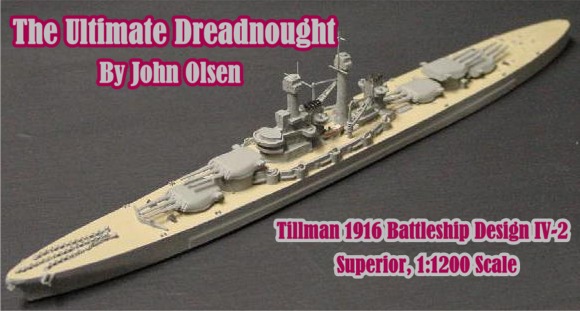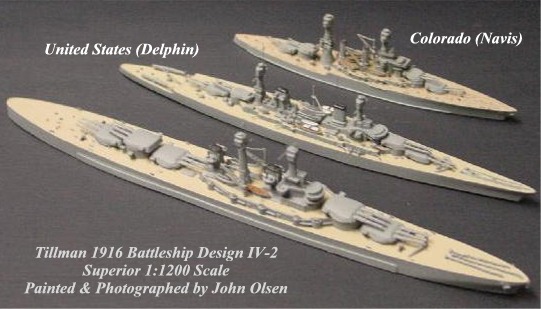 |
 |
In July 1912, a resolution introduced in Congress by Senator Benjamin Tillman (D-SC) of the Senate Naval Affairs Committee directed the Navy to explore the maximum practical limits of battleship design. Ever since the 18,110 ton HMS Dreadnought first appeared in 1906, battleship size had increased incrementally, and the latest generation was now approaching 30,000 tons. Over the next few years the Bureau of Construction and Repair turned out numerous designs; each, at Tillman’s prodding, larger, faster and more heavily armed than the previous. Some of these designs evolved into what later became the Pennsylvania, New Mexico, Tennessee and Colorado classes, but these never approached what Tillman felt were the ultimate limits of size, speed, gun power and protection. In 1916 he succeeded in securing four preliminary designs from C&R that were derived from the still evolving 43,200 ton South Dakota class. Though each varied in armament, protection, horsepower and speed, all were designed to the maximum limits permitted by existing harbor and docking facilities at the time, and dimensions were specifically tailored to fit the locks of the Panama Canal. Each design called for ships that were 975ft x 108ft x 32ft-9in, with a radius of action set at 12,000nm at 10kts. Individual design schemes varied as follows:
In January 1917, Design 4 was further modified by substitution of 18in guns for 16in on the same 80,000 ton displacement. To maintain the same 25.2kt speed, a sacrifice in protection was required that reduced the maximum thickness of the belt armor from 18in to 16in. Redesignated Design IV, this called for two alternate dispositions of the main armament:
It is Design IV-2 that is depicted in Superior’s Special Production Run model (A-126) released for the first time in February 2003. It is a big model (9-3/4in long) of a big ship, the biggest battleship model ever produced at 1:1200 scale, the extraordinary length being a function of the space required for 24 boilers and engines needed to drive such an enormous vessel through the water at over 25kts. As designed, IV-2 had boiler uptakes grouped into three funnels with the cage masts forward of the first and third. Twelve of her 21-6in secondary guns were grouped in six double-level casemate mounts in the central superstructure (02 and 03 levels), with four sited in single casemate mounts on the 01 level abreast of the conning tower and B turret, and the remaining five in recessed casemates on each quarter (4) and directly astern (1).
 |
The model takes the liberty of improving this design by reducing the number of funnels to two (with a mast-funnel arrangement similar to the older Delaware and North Dakota) and rearranging the disposition of the secondary armament to ten single casemates on the 01 level and ten open mounts directly above these. The bridge is modified to a tower structure similar to the Tennessee and Colorado classes, and boat cranes of the type carried on those two classes are provided amidships along with a full complement of boats. Searchlights are sited in pairs on either side of each funnel with control stations below, and two-level fire control tops are fitted to each mast. No aircraft arrangements are provided, though there is ample room on the vast quarterdeck to be creative. These modifications are convincing when one considers the effect the adoption of small-tube boilers at this time had on reducing the number of funnels on the Constellation class battlecruisers from seven to two, and the general dissatisfaction of the Bureau of Ordnance with the performance of the 6in secondary gun. Though the South Dakotas carried the double-level casemates to the final drawings, it’s not inconceivable that this poor arrangement would have been modified and a different type of gun substituted.
The biggest disappointment is the hull form, particularly around the bows. The freeboard is excessive and the lines of the bows should be much finer. The original plans show a much cleaner entry and a greater flare at the forecastle, which would have kept them drier forward. Due to its great length and the casting process involved, the model does not sit quite flush at the waterline, so several passes with a coarse rasp are necessary to even out the dips. This also serves to reduce the high freeboard, which affords a more graceful profile. The usual Superior hallmarks are also present: over-scale anchor chain, scribed decks, solid cage masts with crosshatch scribing, and a good deal of flash and vent plugs that have to be sanded down before finishing. Still, with a little work (I just added topmasts) the model is good value for its cost, and is a must in any collection of never-built ships. Wargamers will certainly be delighted!
In conclusion, these design studies served a useful purpose in showing what form a maximum buildout at this time might have assumed. These monsters, however, at the stage to which their design was taken, embodied no breakthroughs in design or construction such as sloped armor or enhanced internal subdivision. Their protection relied on the old pre-WWI belt/protective deck system, and their underwater cross-section is essentially the same multi-layer internal subdivision system as was designed for the Colorado class. Further design work might have seen this radically modified as the lessons of Jutland and the potential for air attack were taken into account, and these ships might have emerged, at astronomical cost, as a new defining type. As an operational rule, Navy Secretary Josephus Daniels favored classes of six, with five operating as a division so that one could be kept under repair at any given time. No names or numbers were ever assigned, though it’s interesting to speculate if the nomenclature would have followed the convention of state names due to their overwhelming size and strength. However, given the state of the economy and the mood of the nation after WWI, the likelihood of a "President" or "Freedom" class of six American superbattleships keeping the seas safe for democracy in the Roaring 20’s was pretty remote!
(Reference: Freeman, Norman, U.S. Battleships, an Illustrated Design History, Annapolis: U.S. Naval Institute, 1992)